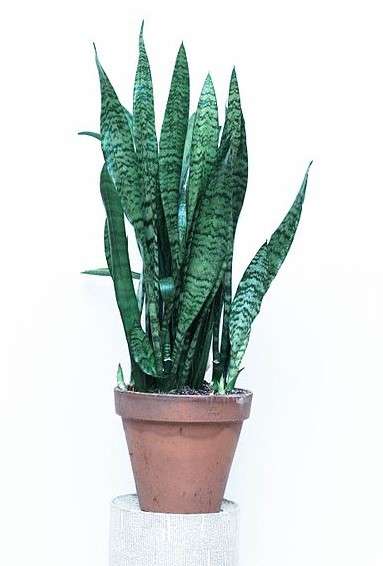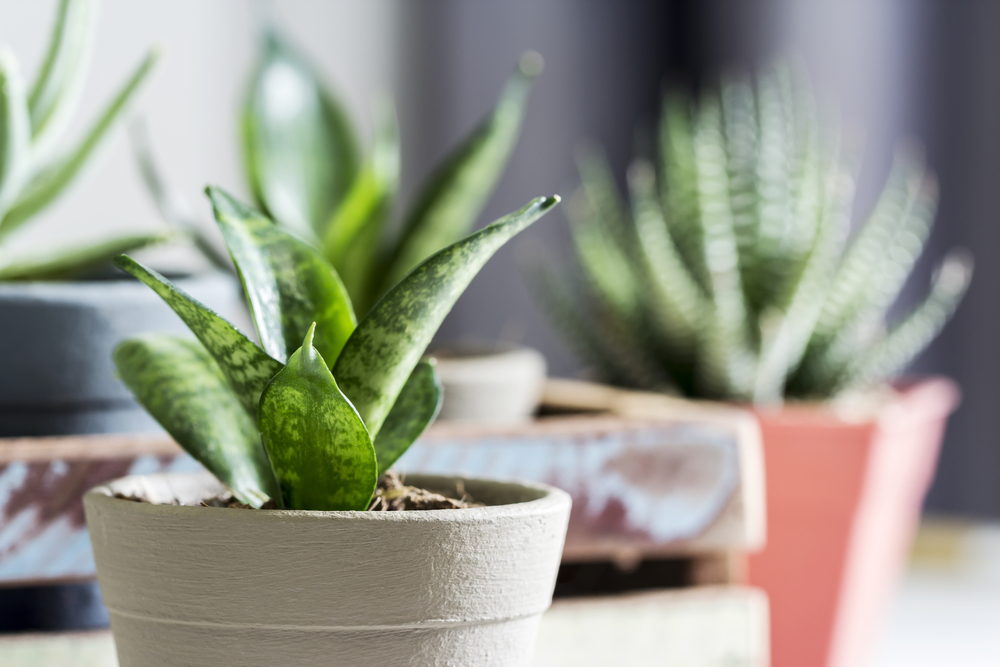This post may contain affiliate links. As an Amazon Associate we earn from qualifying purchases.
The skinny on how to care for a snake plant.
Whether you choose to call it Sansevieria, after its binomial name (Sansevieria spp.) or by one of its many common names, such as mother-in-law’s tongue, or snake plant, the folks where you buy your houseplants will know what you’re talking about.
The most commonly grown Sansevieria (as houseplants) is Sansevieria trifasciata var. laurentii.
It’s a houseplant worth having, for a number of reasons. First, like one of my favorites, the peace lily, the snake plant is tolerant of those shady corners in the home. It also won’t keel over and die on you if you forget to water it now and then. And, terrarium gardeners will love it for both of those reasons and more (consider the dwarf snake plants. Find them at Amazon.com).
Best of all? Bugs don’t like the snake plant so that’s one less thing to worry about.
Like most houseplants, this one is tropical in nature, unlike many, it is not particular about care and it lives a long time.
Here’s what you’ll need to care for a snake plant:
- Standard, quality potting soil
- Cactus potting mix
- Planting pot with holes in the bottom
- All-purpose houseplant fertilizer

Snake Plant light requirements
Although the snake plant tolerates low light levels it does much better in a brighter setting. But, not too bright. Direct sunlight will burn that tall, gorgeous foliage.
Try placing the snake plant in different areas of the home for a few weeks at a time to find out where it does best. If the leaves tend to bend or flop over, give it additional light. If the coloring changes it may be getting too much light. Snake plants with variegated foliage generally require less bright light to keep their color.
How and when to water the snake plant
About the only way you can kill a snake plant is by overwatering it. Remember, this is a succulent, so treat it like one. The golden rule when you care for a snake plant is that “Too much water, too often, will cause the roots to rot.”
Stick your index finger into the soil. When the top half of your finger comes out dry, it’s time to water. Place the pot in the sink or bathtub and run water slowly over the soil (try to keep the foliage dry) until the excess water drains from the bottom of the pot.
Then, forget about the plant. Really. Don’t baby it.
Fertilize your snake plant, or don’t
As succulents, snake plants don’t require fertilizer. Professional growers claim that an application of basic houseplant fertilizer in spring and summer won’t hurt it, but it won’t die without it.
Fertilize only during the growing season. Use a balanced fertilizer (all three numbers the same, such as 10-10-10) but dilute it to one-fourth the strength recommended on the fertilizer label.

Repotting the snake plant
You’ll know it’s time to repot the snake plant if you see roots snaking out of the pot’s drain holes, or if the water runs right through the plant quickly or if the soil shows signs of salt build-up.
Summer is the ideal time to transplant. This gives the roots time to adjust to their new digs before settling in for the rest period of winter.
Choose a pot one or two sizes larger than the current pot. I like to go up only one size with the snake plant because they seem to do better when a bit root-bound. I also choose terra cotta pots for the snake plant instead of plastic.
When choosing a fresh potting mix, remember, again, that this is a succulent with roots that don’t tolerate a lot of moisture hanging around. A mixture of quality potting mix and cactus mix will offer adequate drainage for the snake plant.
When removing the plant from its current pot, use care to not hold it by the foliage. Lay the pot on its side and, if it’s a plastic pot, press the sides of the pot to loosen any roots that might be clinging.
Grab the snake plant as close as you can to the soil and gently slide it from the pot. Before planting it in the larger pot, determine if it’s a candidate for division. Read the next section to find out why and how to do it.

Snake plant propagation
When the snake plant produces pups (small versions of themselves), cut them off and pot them up. Give them the same amount of light as the parent plant and keep the soil just slightly moist. When the plant roots, cut back on the water.
Like other succulents, the plant can also be propagated by leaf cuttings. Cut a long leaf into sections about 2 to 3 inches in length. Stick the cut end into cactus mix that’s slightly damp. It may take more than a month to root this way, but typically it’s quicker.
If you are repotting your snake plant, you can divide the rhizome into sections (each with some roots) and repot them to make new snake plants. Again, keep the mix moist, give them lots of light and back off on watering as soon as you see new growth.
According to the ASPCA, the snake plant is toxic to cats and dogs. Chewing or ingestion can result in vomiting and diarrhea. Find a list of pet-safe houseplants here on Gardenologist.org.
Where to buy snake plant? Check out these beauties at Perfect Plants.
Resources
Houseplant fertilizer




